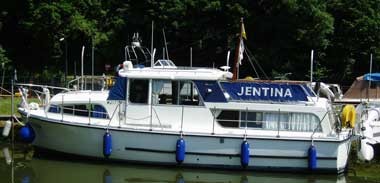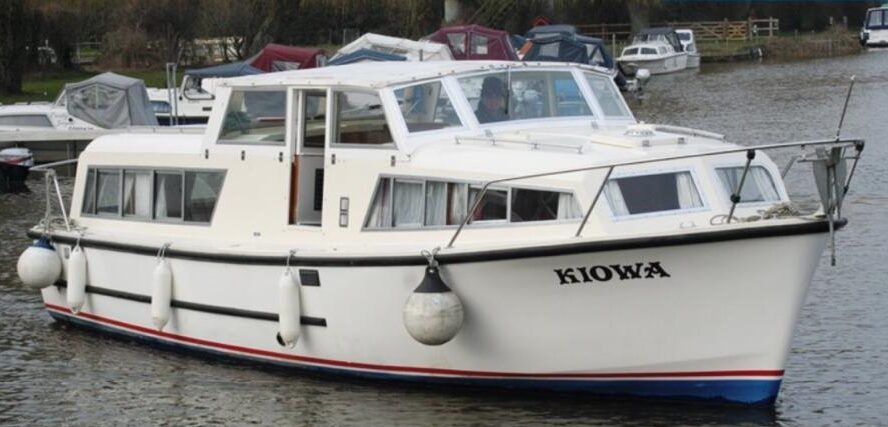
Broom 30 & Skipper








Sharing the same round-bilged GRP hull as the Ocean 30, designed by Mr R.M. “Rip” Martins who was a naval architect, the Broom 30 is distinguished by its midships wheelhouse saloon, with sliding doors on both sides. The superstructure and interior were designed by Mr Martin Broom and four pre-1968 boats had a mahogany superstructure and teak-laid deck, after which time the construction was all GRP. Wooden uprights in the forward windscreen and wooden wheelhouse door frames were also phased out in later models.
Most people are surprised by the spaciousness of the interior, which provides four single berths in two cabins, a wheelhouse/saloon with a convertible settee and sunroof, two bathrooms and a ‘corridor’ galley. Some boats have had a helm position retro-fitted to the aft cabin roof, behind the wheelhouse/saloon, increasing air draught to 9ft. The ‘Skipper’ variant of the Broom 30 was produced with a soft-top and hinge-down windscreen and sides to the wheelhouse/saloon to give an air draught suitable for the Upper Thames, the Broads and other cruising grounds with low bridges. On these models, the wheelhouse is smaller, with a larger saloon and galley aft.
Engines are mostly Perkins 4-cylinder diesels ranging from 35 to 70hp in either single or twin configurations. The difference in top speeds between these is only about 1 knot.

| LOA: | 30ft 0in / 9.14m |
| Beam: | 10ft 4in / 3.15m |
| Draught: | 2ft 6in / 0.76m |
| Min. Air Draught: | 8ft 0in / 2.44m (6ft 6in on Skipper) |
| Hull/Deck: | GRP/Wood or GRP |
| Hull Form: | Displacement |
| Cruise Speed: | 7 knots |
| Max. Speed: | 9 knots |
| Fuel Capacity: | 40 gals / 182 ltr |
| Water Capacity: | 90 gals / 410ltr |
| Build Period: | 1966 – 1981 |
| Number Built: | 250 |
| Previous Model: | Bosun |
| Successor Model: | Broom 29 |
| Market Value: | £25,000 – 35,000 |
8 Comments
-
-
Sytse Kuijk
Interesting page, cool to see these. Most of all, I am surprised to learn that there were only 4 Ocean 30 with mahogany top and teak deck. It just so happend that I am the owner of one of these. It was constructed in 1967 as Dorena (or something similar), but while still young sold to someone who renamed it Fliptail. This is the name that it still carries. My father bought the Fliptail around 1977, and we spent many holidays happily with it. In those years I did the bulk of the maintenance (mainly on the wood, obviously) as I was the son with most interest in the Fliptail. We also had a small plastic dinghy named Tailflip that followed wherever the Fliptail went. The Tailflip lost its function and got leakages problems, after which had to leave it behind. The Fliptail also suffered damage when colliding with a barge in a moment of lapse of attention of my father as was damaged. It was repaired carefully and recovered its seaworthiness. Around 1993, my father lost interest in the boat and I bought it from him. We then did some thorough rework on it, to preserve it better, by covering the exterior wood surfaces to glassfiber and epoxy, maintaining the colour and appearance whilst reducing the maintenance needs vastly. At the same time we resurfaced the top white decks and also there applied a (much thicker) layer of glass fiber and epoxy before applying a nice glossy white paint again. Two years later we actually had to sacrifice the teak deck, as the (rusting) screws applied from the bottom upwards were showing through the teak layer, and letting quite some water leak towards the inside. We replaced the deck by an identical teak one by a wharf that had a guy that specialised in teak. This was in 1997 and the new deck is still today almost impeccable. We have been maintaining the Fliptail with lots of care and love, and make sure it is kept well despite being full wood on the top. This wood, at some key points, tend to split and then be a problem for water seeping in. When that happens, i remove a bit of mahogany around the fissure, at an angle so that if it is not completely watertight, the water will tend to obey gravity and stay outside. This is a recurring operation, every couple of years. In 2010 we replaces the venerable Perkings engines by new Mitsubishi marine ready 35hp modern engines, new transmissions and homokinetic couplings. We reduced the axel rpm by applying a 2:1 transmission ratio, and changed the propellors from 12" to 16". Going well, we will be sailing soon again.
-
Toby
Hi Sytse, It was my Dad that named it Fliptail! We would go on holidays on the Broads. I’m sure I can find photos. I’m glad if gave your family happy memories too! Best wishes Toby
-
-
Peter van der Wal
Our Broom 30 ( Berra) does not have CE marking because it was built before 1995. Which category would the Broom 30 fall into?
-
Mladen
Hi all, I bought Broom Ocean 30 built in 1979 and am restoring it slowly. I am wondering about the water tank, it is laminated in, at the front central part of the bilge. I am wondering is it all GRP, or the tank itself is steel, laminated into the hull? I would expect after 45 years it is leaking into the hull if it is GRP only. I will not use it for drinkable water, wondering what to do about it, it is 420 kg of balast if full. The boat is on Irish canals so no worries about stability. It got Mercedes OM 636, hydraulic steering and the gearbox. Thanks!


Donald & Marjorie Walker
This all looks very impressive. Enjoying looking through the models gallery where it would be god to have more photos. I also need to provide a "current news and events section for the European page, which I will do before the site goes live. Other comment to Louise by e mail.